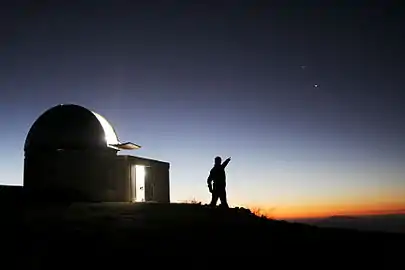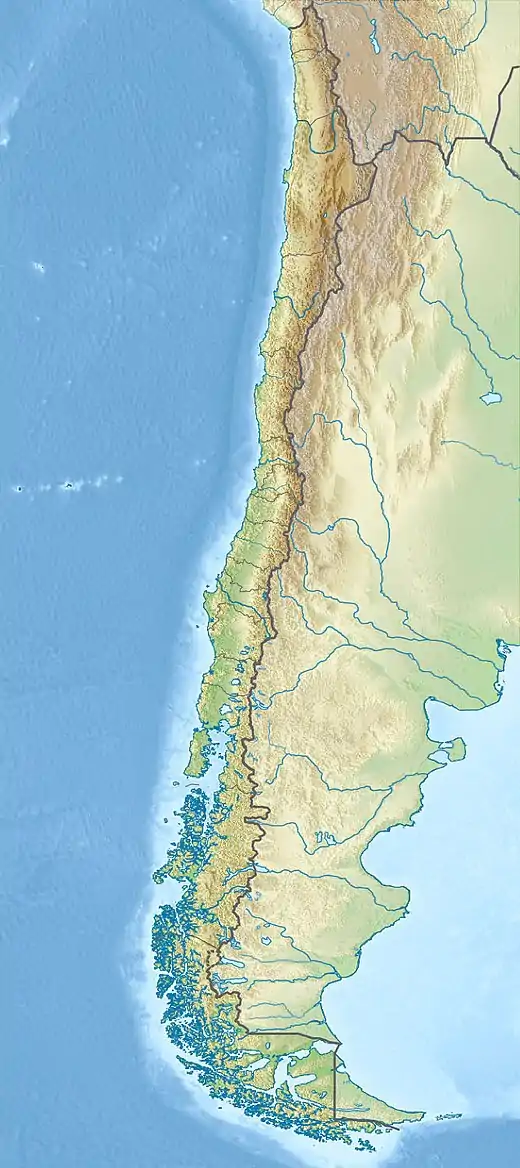TRAPPIST
The Transiting Planets and Planetesimals Small Telescope (TRAPPIST) is the corporate name for a pair of Belgian optic robotic telescopes. TRAPPIST–South, which is situated high in the Chilean mountains at ESO's La Silla Observatory, came online in 2010, and TRAPPIST–North situated at the Oukaïmeden Observatory in the Atlas Mountains in Morocco, came online in 2016.[1]
 | |
| Part of | La Silla Observatory Oukaïmeden Observatory |
|---|---|
| Location(s) | Coquimbo Region, Chile |
| Coordinates | 29°15′17″S 70°44′22″W |
| Organization | University of Liège |
| Observatory code | I40 |
| Altitude | 2,400 m (7,900 ft) |
| Telescope style | Robotic optical telescope |
| Website | www |
 Location of TRAPPIST | |
Description
TRAPPIST is controlled from Liège, Belgium, with some autonomous features. It consists of two 60 cm (24 in) reflecting robotic telescopes located at the ESO La Silla Observatory (housed in the dome of the retired Swiss T70 telescope) in Chile and at Oukaïmeden Observatory in Morocco.
The 60 cm f/8 Ritchey–Chrétien design telescopes and New Technology Mount NTM-500 were built by ASTELCO Systems, a company in Germany. The CCD camera was built by Finger Lakes Instrumentation (USA), providing a 22 x 22 arcminutes field of view. The camera is fitted with a double filter wheel, allowing 12 different filters and one clear position.[2][3]
The telescope condominium is a joint venture between the University of Liège, Belgium, and Geneva Observatory, Switzerland, and among other tasks, it specializes in searching for comets and exoplanets.[4][5]
In November 2010, it was one of the few telescopes that observed a stellar occultation of the planetary body Eris, revealing that it may be smaller than Pluto, and it helped observe a stellar occultation by Makemake, when it passed in front of the star NOMAD 1181-0235723. The observations of this event showed it lacked a significant atmosphere.[5][6]
A team of astronomers headed by Michaël Gillon, of the Institut d’Astrophysique et Géophysique at the University of Liège in Belgium, used the telescope to observe the ultracool dwarf star 2MASS J23062928-0502285, now also known as TRAPPIST-1. By utilising transit photometry, they discovered seven terrestrial planets, at least three of which were Earth-sized, orbiting the star; the innermost two were found to be tidally locked to their host star while the outermost appears to lie either within the system's habitable zone or just outside of it.[7][8] The team published its findings in the May 2016 issue of the Nature journal.[9]
Name
As with the other space observation projects of the University of Liège like SPECULOOS, Transiting Planets and Planetesimals Small Telescope makes up a backronym, referring to traditional Belgian Trappist beer.[10]
Gallery
 The 60 cm telescope is operated from Liège, Belgium, 12000 km away.
The 60 cm telescope is operated from Liège, Belgium, 12000 km away. TRAPPIST's enclosure
TRAPPIST's enclosure TRAPPIST is housed at the former Swiss T70 telescope site
TRAPPIST is housed at the former Swiss T70 telescope site_by_TRAPPIST_on_2013-11-15.jpg.webp) Comet ISON as captured by TRAPPIST before the comet disintegrated a few days later
Comet ISON as captured by TRAPPIST before the comet disintegrated a few days later First light image of the Tarantula Nebula taken by TRAPPIST in 2010
First light image of the Tarantula Nebula taken by TRAPPIST in 2010
See also
| Wikimedia Commons has media related to TRAPPIST telescope. |
- Carlsberg Meridian Telescope, a high-precision optical astrometry observatory
- SPECULOOS, a project of the University of Liège to search for exoplanets
References
- "TRAPPIST-1". trappist.one. Retrieved 6 March 2018.
- "The Messenger no. 145" (pdf). European Southern Observatory. September 2011. Retrieved 2020-03-21.
- "ASTELCO Systems - Projects". www.astelco.com. Retrieved 2020-03-21.
- "TRAPPIST telescope to scout the sky and uncover exoplanets and comets". Science Daily. June 9, 2010. Retrieved March 6, 2018.
- Beatty, Kelly (8 November 2010). "Former 'tenth planet' may be smaller than Pluto". New Scientist. Retrieved 6 March 2018.
- "Dwarf Planet Makemake Lacks Atmosphere". European Southern Observatory (ESO 1246). 21 November 2012. Retrieved 6 March 2018.
- "Three Potentially Habitable Worlds Found Around Nearby Ultracool Dwarf Star – Currently the best place to search for life beyond the Solar System". European Southern Observatory. Retrieved 2 May 2016.
- "Three New Planets Are the Best Bets for Life". Popular Mechanics. 2 May 2016. Retrieved 2 May 2016.
- Gillon, Michaël; et al. (12 May 2016). "Temperate Earth-sized planets transiting a nearby ultracool dwarf star". Nature. 533 (7602): 221–224. arXiv:1605.07211. Bibcode:2016Natur.533..221G. doi:10.1038/nature17448. PMC 5321506. PMID 27135924.
- "New National Telescope at La Silla—TRAPPIST to Scout the Sky and Uncover Exoplanets and Comets". European Southern Observatory (ESO 1023 – Organisation Release). 8 June 2010. Retrieved 4 January 2015.